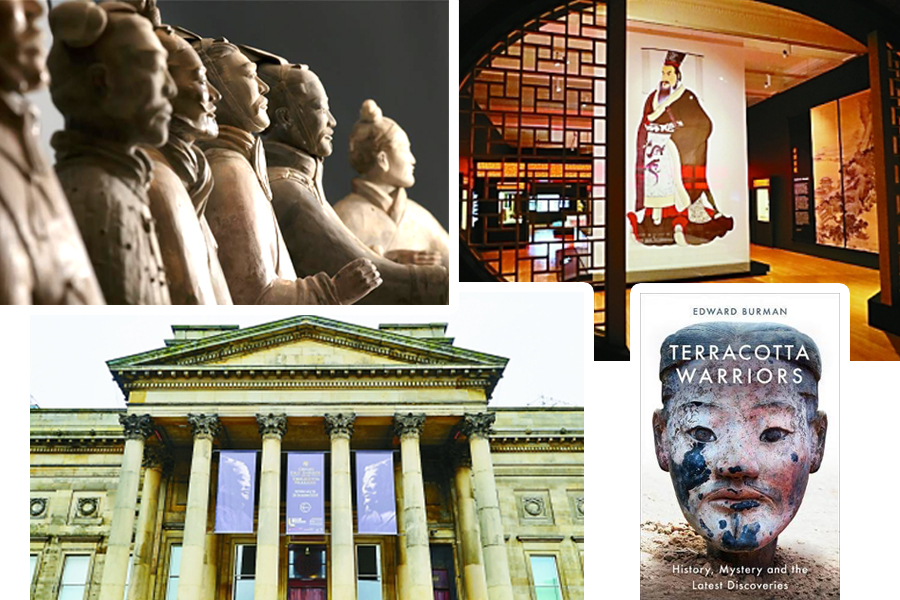China’s Terracotta Warriors displayed in Liverpool

Terracotta warriors on display, painting of Qin Shi Huang, Liverpool’s World Museum and the book Terracotta Warrior: History Mystery, and the Latest Discoveries
The exhibition will display 120 relics at the World Museum in Liverpool, showcasing about 700 years of Chinese history spanning from the Warring States period (475-221BC), to Qin (221-206BC) and Han dynasties (206BC-220AD). The relics include terracotta warriors and a selection of ancient artifacts provided by 13 museums and research institutes in China’s northwest Shaanxi Province.
Established in 1851, the World Museum has a collection of approximately 1.7 million items and attracts about 600,000 visitors per year. It is also one of the nine members of the National Museums Liverpool. The organization plans to hold 18 exhibitions this year to celebrate the 10th anniversary of Liverpool becoming the European Capital of Culture for 2008.
Liverpool is home to Europe’s oldest Chinese community. It is a great choice to hold the exhibition here, said David Fleming, director of the World Museum. Liverpool played a crucial role in the history of China-UK relations. The first commercial ship from China arrived at Liverpool wharf back in 1834, carrying the first Chinese people to set foot in Europe. In the 1860s, a massive number of Chinese crew members were employed by Alfred Holt & Co. They built Europe’s first Chinese community and Chinatown. Today, the University of Liverpool is home to the largest crowd of overseas Chinese students in Europe. And the exhibition of terracotta army will definitely leave a significant mark on its history.
A team of designers, architecture professionals and museum staff built a visiting route in the exhibition hall, allowing viewers to travel through time and get a glimpse of what China was like thousands of years ago. Also, they adopted typical Chinese elements to decorate the space. For example, the shape of the corridor is inspired by lanterns and the words of introduction are printed in Xiao Zhuan, a style of calligraphy used in the Qin Dynasty.
The World Museum described the event as an “unmissable” exhibition that displays “objects from one of the world’s greatest archaeological discoveries.” The amazing artifacts tell the story of the emperor’s pursuit of immortality and his preparation for the afterlife. Also, they help visitors to understand everyday life of China 2,000 years ago.
What deserves attention is a multi-dimensional virtual representation of the emperor’s mausoleum. For the sake of preservation, the Chinese government has not unearthed the tomb. The organizer draws on limited historical records so that visitors can explore the period time.
Relics collected in Shaanxi Province, represented by Terracotta Warriors have been showcased in many countries, which has accumulated abundant experience for overseas exhibitions. Serving as a diplomatic envoy and a national name card, the exhibitions are an irreplaceable way to show the world what China is about.
China’s terracotta army marched to the United Kingdom for four times. The exhibition came to Edinburg in 1985 and appeared in London in 1987, 1999 and 2007. More than 850,000 people visited the 2007 event in the British Museum, which was the museum’s most successful after the 1972 exhibition about Pharaoh Tutankhamun of Egypt. A number of people even waited at the door as early as 5:30 a.m. to see the genuine Terracotta Warriors when the spectacular artifacts went on display in London for the first time. The British Museum had sold 400,000 tickets before the exhibition started and the number was dozens of times of the previous record.
British writer Edward Burman’s book Terracotta Warrior: History Mystery and the Latest Discoveries was recently published in Britain, becoming a major work on Qin history in the English-speaking world. With the full support of the Shaanxi Provincial Cultural Relics Bureau, Burman went to Qin sites and visited the leading Chinese archaeologists and historians for three years. It is the first book available for the general reader to understand most recent excavations and new discoveries of the terracotta army.
British people would think of Terracotta Warriors, the Great Wall and the Palace Museum when it comes to Chinese history. They are obsessed with the size, scale and craftsman of the warriors and horses as well as the mystery brought by the mausoleum of Qin Shi Huang. However, Leon Rocha, a lecturer on Chinese studies from University of Liverpool, pointed out that Chinese history accounts for an excessively small proportion in British education. In this context, the exhibition matters a lot.
The World Museum will make great contributions if the exhibition attracts more students to study the history of the Warring States period as well as Qin and Han dynasties, or encourages them to learn Chinese or visit China, Rocha said.
(edited by MA YUHONG)

 PRINT
PRINT CLOSE
CLOSE